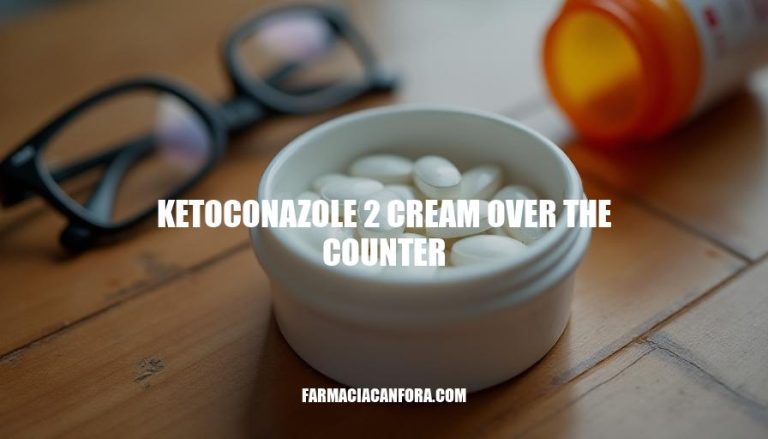


Ketoconazole 2% cream is an over-the-counter topical antifungal medication. It is primarily used to treat various fungal skin infections, such as athlete’s foot, jock itch, ringworm, and seborrheic dermatitis. People seek it out because it effectively relieves symptoms like itching, redness, and scaling associated with these conditions, providing relief and promoting healing.
Ketoconazole 2% cream is a topical antifungal medication used to treat various fungal infections of the skin, such as athlete’s foot, jock itch, ringworm, and seborrheic dermatitis. The active ingredient in this cream is ketoconazole, which is a broad-spectrum synthetic antifungal agent.
Ketoconazole works by inhibiting the growth of fungi. It does this by interfering with the fungal cell membrane, leading to the death of the fungal cells.
This helps to clear up the infection and relieve symptoms such as itching, redness, and scaling.
Ketoconazole 2% cream is easily accessible without a prescription, making it convenient for quick treatment of fungal infections. It effectively treats conditions like athlete’s foot, jock itch, ringworm, and seborrheic dermatitis. The cream works by preventing the growth of fungi, providing relief from symptoms such as itching, redness, and scaling.
Its over-the-counter availability ensures that individuals can start treatment promptly without needing to visit a healthcare provider.
Ketoconazole 2% cream can treat the following conditions:
Athlete’s foot (tinea pedis): A fungal infection that affects the skin on the feet.
Ringworm of the body (tinea corporis): A fungal infection that causes a red, circular rash on the skin.
Jock itch (tinea cruris): A fungal infection in the groin area.
Seborrheic dermatitis: A skin condition that causes scaly, red, and itchy patches, often on the scalp.
Tinea versicolor (pityriasis versicolor): A fungal infection that leads to discolored patches on the skin.
Skin yeast infections (cutaneous candidiasis): Fungal infections caused by Candida species on the skin.
To use ketoconazole 2% cream effectively, follow these steps:
Clean the affected area: Wash the area with soap and water, then dry it completely.
Apply the cream: Use a small amount of cream to cover the affected area and a small portion of the surrounding skin.
Frequency: Apply the cream once daily, preferably at night before bed.
Duration: Continue using the cream for the full prescribed duration, usually 2 weeks, even if symptoms improve earlier.
Wash hands: Wash your hands before and after applying the cream to avoid spreading the infection.
Avoid covering: Do not cover the treated area with bandages or dressings unless directed by your doctor.
Avoid contact: Avoid contact with your eyes, mouth, and other mucous membranes.
Monitor for side effects: Be aware of potential side effects such as itching, redness, or irritation. If you experience severe side effects, discontinue use and consult your doctor.
By following these steps, you can ensure the best results from using ketoconazole 2% cream.
Ketoconazole 2% cream can cause side effects such as itching, stinging, burning, or irritation at the application site. Less commonly, it may lead to acne, blistering, crusting, or peeling of the skin. Rarely, users might experience an allergic reaction, which could include symptoms like rash, swelling, or difficulty breathing.
If any severe side effects occur, it’s important to stop using the cream and seek medical attention immediately.
Ketoconazole 2% cream can often be found at major retail pharmacies like CVS, Walgreens, or Boots. Supermarkets with in-store pharmacies like Walmart and Tesco also typically stock it. For online purchases, check Amazon, CVS’s website, or Walgreens’ online store.
Local independent pharmacies might carry it, and European buyers can often find it on EU-specific sites like Chemist Direct. Always ensure you’re getting it from a reputable source.
Ketoconazole 2% cream is an over-the-counter topical antifungal medication used to treat various fungal skin infections, including athlete’s foot, jock itch, ringworm, and seborrheic dermatitis.
It works by inhibiting the growth of fungi, providing relief from symptoms such as itching, redness, and scaling.
The cream is easily accessible without a prescription and can be found at major retail pharmacies and online stores.
However, it’s essential to consult with a healthcare professional before using ketoconazole 2% cream, especially if you have sensitive skin or are unsure about the severity of your condition.
They can provide guidance on proper use and help you determine the best course of treatment for your specific needs.